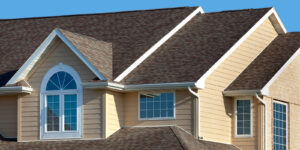When we think of a roofing system, we often think of materials like shingles and insulation. However, the vents on your roof also play a significant role in keeping your house at a consistent and comfortable temperature.
Your insulation and ventilation work together as a system to regulate the temperature in your home. Proper attic ventilation circulates the air, eliminating excess moisture in your attic. When calculating the right ventilation for your home, your roofing contractor will take many measurements into account. These measurements can include the pitch of your roof, the type of insulation you have, and the square footage of your home.
Here are five common roof vent types that you may find on your home:
- Soffit
This screened vent runs along the sides of the house, under the roofing materials allowing air to flow up through the attic and under the roofing materials. Soffit vents can be made from vinyl, aluminum, and continuous material. - Roof Ridge
Usually found on steeper pitched roofs, roof ridge vents run continuously along the roof’s peak, allowing air to escape the attic at the highest point. These vents are covered by a special cap shingle that protects the vent from water while allowing air to flow underneath. - Box
A more common choice on lower-pitched roofs, box or flat roof vents are usually found on residential roofs. Box vents are basic and look like a small box protruding from the shingles with a covering that shields from the weather and sides that allow air in and out. They use wind and convection to get warm air and moisture out of the attic. - Powered
When a simple box vent doesn’t suffice, for example, on a larger home, you will often find a powered vent. These can be routed through the home’s electricity or even use solar power to run. Powered with a fan, these vents are more effective than a static box vent at cycling air in and out of the attic. - Bathroom Exhaust
We often don’t think of the bathroom fan as a type of exterior ventilation. Still, it is an important component to moving hot air and moisture out of the home. When they are installed incorrectly, these vents can dump the hot air and moisture into the attic rather than outside, which leads to mold and mildew in the attic and insulation above.
Improper roof ventilation can cause many roofing issues in both cold and warm weather conditions. It lowers your roofing materials’ lifespan and even causes mold and mildew issues throughout your home. If you’re worried about mold and mildew in the attic, or the temperature inside your home is hard to regulate, find an experienced roofing contractor who can assess your home’s current ventilation and guide you in creating a well-ventilated home.




